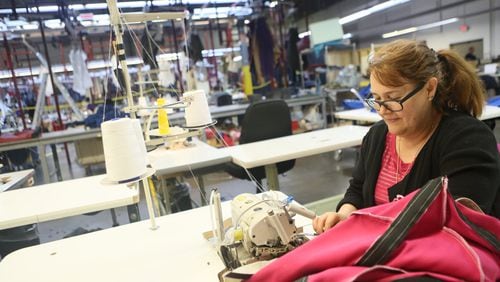The sewing machine is already threaded and ready to go when María Cambrón sits down to work. She eyes the device carefully through her glasses, picks up a piece of fabric, slides it onto the needle plate, and fastens it with the presser foot. The pattern is in place.
One touch to the floor pedal is enough for Cambrón to begin sewing. The fast, rhythmic sounds of the sewing machine are difficult to ignore.
One piece, two pieces, three pieces… this has been Cambrón’s life for the last seven years, while working at Luvu Brands, a furniture manufacturer located in Doraville. Thirty percent of the factory’s workforce is Hispanic.
“As a little girl I would sew dresses for my dolls. I made clothing for them. I’ve always liked sewing. I’ve been a seamstress for as long as I can remember,” said Cambrón, who came to the United States from her native Mexico 27 years ago.
Through sewing, Cambrón has fulfilled her own ‘American Dream.’ Despite finding the English language to be complicated, it has not proven to be an issue for Cambrón or her coworkers.
“We communicate with signs, using our hands…,” explained María Monzón, a supervisor who has lived in the U.S. since 1979.
Monzón, who is originally from El Salvador, also began her career as a seamstress. She learned the trade when she was 16 years old. It is a skill that has served her well as an immigrant, she adds. “Every day I wake up at 5:00 in the morning to work with my group. For me, the best thing about being here is arriving in the morning and greeting my coworkers,” said Monzón.
She further explained that perhaps the most challenging aspect of her work environment is knowing how to treat the staff, with the presence of so many cultural differences. “You have to keep in mind that we are all equal and that we all came here because of needs we have.”
Another 50 percent of the factory’s workforce is comprised of immigrants from Vietnam, Russia, South Korea and several countries in Africa.
The topic of immigration and President Trump’s new polices are often points of discussion for the workers.
“I’m alright, thank God, but I am worried about those who came here at a young age and are having a hard time getting ahead,” said Monzón.
Alongside Monzón are Blanca Quintanilla and Franklin Conejo, who are from Mexico and Costa Rica, respectively. Both workers also feel they are living the ‘American Dream,’ thanks to their jobs and their skills.
“I came to Atlanta in 1999 and I began working in construction, until I found out about this position in the newspaper,” said Conejo, whose main job is making backstitches.
Like many other immigrants, Conejo lives alone. His work family, however, provides him with a strong support system.
“Your coworkers take you in. The thing I like best is the diversity you see, getting to know the different cultures and even trying different foods during lunchtime,” he explained.
Quintanilla, a native of Nuevo León, México and who arrived in Georgia in 1994, agrees with Conejo.
“It’s nice working with so many people from all over the world. You get to know more about yourself, you get to know other cultures, and you learn so many things. When we share food, when we coexist and try to communicate with each other, even though it’s not the same language, it’s nice,” said Quintanilla.
For Jorge Ramírez, a production manager, that diversity is vital to the business’s development.
“Sewing is becoming obsolete here in the United States, because many things are being produced in China. So, by force, and in order to create more competitive products, we have to maintain that diversity,” explained Ramírez, who began by cutting furniture filling sponges at the factory and little by little worked his way up to a management position with the company.
On the other hand, he points out that there are challenges involved with working with people from other cultures.
“It’s difficult. Everyone is different, and you always have to treat them with respect. We have people from Japan, Europe, Mexico, Colombia, El Salvador, Peru…,” said Ramírez.
According to the manager, however, at the end of the day it is about learning from others and “getting the best out of each one.”
“It’s a pleasant experience to work with so much diversity. I had my own personality, and by getting to know the diversity of other cultures, I changed, and I learned,” added Ramírez.
Maintaining that diversity is one of the company’s main objectives.
Ramírez’s vision is one established by Louis Friedman, owner and Executive Director of Luvu Brands, a company which includes three other brands (Jaxx, Avana, and Liberator) and which employs approximately 165 individuals.
“For us it’s not just about seamstresses; it’s about artisans who have a lot of skill. We are firm believers in that we should make the products here, with our people,” assured Friedman.
To that end, diversity in the workplace is essential, according to the executive.
“Even more important, though, are the abilities these people have and which they probably bring with them from other factories where they have worked in their countries of origin. Our employees are very important to our development,” said Friedman.
Growing diversity
In fact, a recently published study by the Pew Research Center (2017) indicates that the workforce in this country is becoming more and more diverse.
“Hispanic participation in the workforce increased from 14.3 percent in 2007, to 17 percent last month,” according to the study.
Although these numbers do not speak to data gathered from the textile industry specifically, they do reflect how the Latino workforce has grown in the U.S.
In Georgia, at least, in the textile industry, some 50,240 jobs exist in 820 factories. Of that number, 22.2 percent of the employees are Hispanic, according to recent statistics from the Georgia Department of Economic Development.
“The textile industry has always been an important component in the state of Georgia. And it remains important given its continuous viability,” confirmed Roy Bowen, President of the Georgia Association of Manufacturers, in an interview with MundoHispánico.
The organization represents the textile industry in the state and has served its members since 1900.
“The textile industry requires many skills from its employees, since jobs can vary from making fireman uniforms, up to high fashion pieces,” assured Bowen.
For Bowen, the industry is not particular to just one state.
“Textile companies in Georgia depend on the North American Free Trade Agreement to supply companies in Mexico,” he explained.
Therefore, “producing cotton, for example, isn’t something that can only be done in Kansas. Here in Georgia we are finding more and more textile companies that are producing new products to also supply Central and South America,” said Bowen.
Industry of opportunity
Among those who believe that the sewing industry in Georgia is diverse and a field where opportunities are plentiful is Marcela Ramos.
Ramos came to the U.S. from her native Mexico in 1997. She opened her own crocheting company, Ladies of Crochet, five years ago.
It is a talent she has nurtured for the last three decades.
“Ladies of Crochet came about when my mother-in-law began teaching me to crochet during my first pregnancy. I would always do it to make gifts for my children. But a few years ago, a friend recommended that I start selling my pieces,” explained Ramos.
Her business started as a garage sale and has grown to its current location in Norcross. Ramos has not stopped working since, receiving a minimum of five order requests a week.
Ramos had the opportunity to resign from her job and dedicate herself full time to crocheting, she said. Ramos is part of a new generation of sewing artisans who are not necessarily taken into account by general statistics.
While her business is established and thriving now, the first year was complicated. “It was difficult,” she recalls.
By attending community events, advertising her product via social media, and working closely with non-profit organizations, however, Ramos has achieved success.
Today, she even teaches sewing classes to other women and, through her work, donations are made to cancer patients and nursing homes.
“I’ve never been without work. It’s always been constant,” said Ramos.
For Ramos, her industry is a stable one which consistently offers her opportunities for growth. Not just to her, but to other women as well.
“The work never ends. There are always new techniques that we can incorporate to offer a better product,” she adds.
Ramos has advice for the community and for anyone who is gifted with their hand: “We have the ability to do this. Be inspired. Anything is possible. There are no obstacles. Try to do it,” she implores.
About the Author






